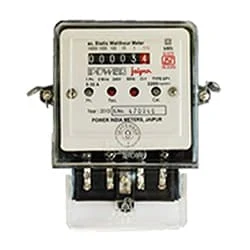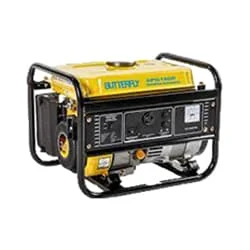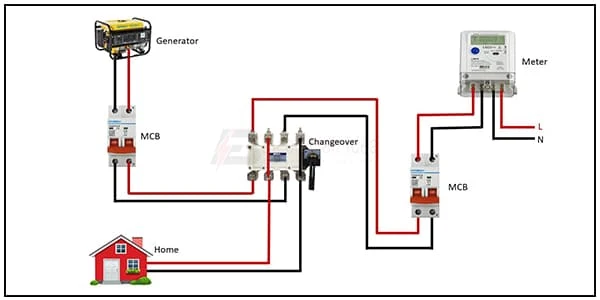Electric Manual Changeover Switch connection | Changeover connection
Electric Manual Changeover Switch connection:
This diagram shows how to connect Electric Manual Changeover Switch connection. In this circuit, we use two DP MCBs ( Double Pole Miniature Circuit Breaker), a changeover switch, a single-phase energy meter and a power generator. This circuit connection is very easy. If you want to see connection animation please check our youtube video below the post.
Diagram of Electric Manual Changeover Switch wiring:
Components Need for this Project:
You can get the components from any of the sites below:
- Changeover Switch [See Buy Click Amazon]
- DP MCB [See Buy Click Amazon]
- Single Phase Energy Meter [See Buy Click Amazon]
- Power Generator [See Buy Click Amazon]
*Please note: These are affiliate links. I may make a commission if you buy the components through these links. I would appreciate your support in this way!
$ads={1}Read Also:
Components used to make the Electric Manual Changeover Switch:
01. Changeover Switch
 |
| Fig 2: Changeover Switch |
Change-Over Switch A single switching system used to operate one of the electrical systems in the absence of power from two sources (generator and PDB) is called a change over switch. Another is the PDB or Palli Vidyut Samity line made from generators or inverters. When the PDB/Rural power line is on, your company's generator line is off. Again when the PDB line goes off your company's generator line will come on again. The switching system to control these two types of electrical systems is called an automatic change-over switching system.
02. DP MCB
 |
| Fig 3: DP MCB |
Double pole MCB can control two wires. This circuit breaker is generally used in single-phase electric lines. Double pole MCB circuit breaker input has two wires supply two wires and an output. In a single-phase line, A double-pole MCB circuit breaker is used to give good production. This circuit breaker is provided through phase and neutral circuit breaker, it is very safe. This circuit breaker is preferred for home appliances. A DP MCB usually trips for 2 reasons 1. Overload 2. Short circuit.
03. Single Phase Energy Meter
 |
| Fig 4: Single Phase Energy Meter |
The measuring device with the help of which the electric power or energy of a circuit is measured is called Energy Meter (Energy Meter). Also called a watt-hour or kilowatt-hour meter. For home appliances, we used a single-phase energy meter. The single-phase energy meter is directly connected between the line and the load. Both coils produce their magnetic fields, when the meter is connected to the supply line, and the load. Energy meters are used in homes and in industrial applications where we want to found that how much energy is being consumed by home appliances and electrical equipment.
04. Power Generator
 |
| Fig 5: Power Generator |
The Power Generator Is a Device That Converts Motive Power (Mechanical Energy) or Fuel-Based Power (Chemical Energy) Into Electric Power for Use in an External Circuit. In Addition to Electromechanical Designs, Photo Voltaic, And Fuel Cell-Powered Generators Utilize Solar Power and Hydrogen-Based Fuels, Respectively, to Generate Electrical Output. The Reverse Conversion of Electrical Energy Into Mechanical Energy is Done by an Electric Motor, And Motors, And Generators Have Many Similarities. Many Motors can be Mechanically Driven to Generate Electricity; Frequently They Make Acceptable Manual Generators.
Thank You for visiting the website. Keep visiting for more Updates
$ads={2}
Frequently Asked Questions
What is the principle of a changeover switch?
A “change-over” closes one circuit or simultaneously opens a second circuit. Thus a “change-over” simultaneously fulfills the function of a “normally open” or also a “normally closed” contact. This means that, in operation, a “change-over” can only ever have one connected circuit diagram closed and one energized.
How do manual switches work?
A manual switch is exactly what it sounds like manual. The power supply is made available from your generator at the flip of a switch, quickly swapping designated circuits diagram over to generator power in the event of an emergency or outage.
What is the difference between manual and automatic changeover switch?
Unlike a manual transfer switch, automatic transfer of the switches can be used with permanently installed standby generators. That way, when your power supply is disrupted and your company is subject to blackouts, your generator will automatically kick on and supply an emergency backup power supply to your building.
What are the disadvantages of a manual changeover switch?
Like all other equipment, a manual changeover switch also has some limitations, such as Someone must switch on an MTS manually. The changeover time required is longer, especially if the generator is away from the building.
What are the different types of manual change-over switches?
Manual change-over of the switches is available with three different transition types; Open, fast, and closed. Change-over switches by ABB are extremely well-suited for heavy-duty applications.






Post a Comment
Do leave your comments